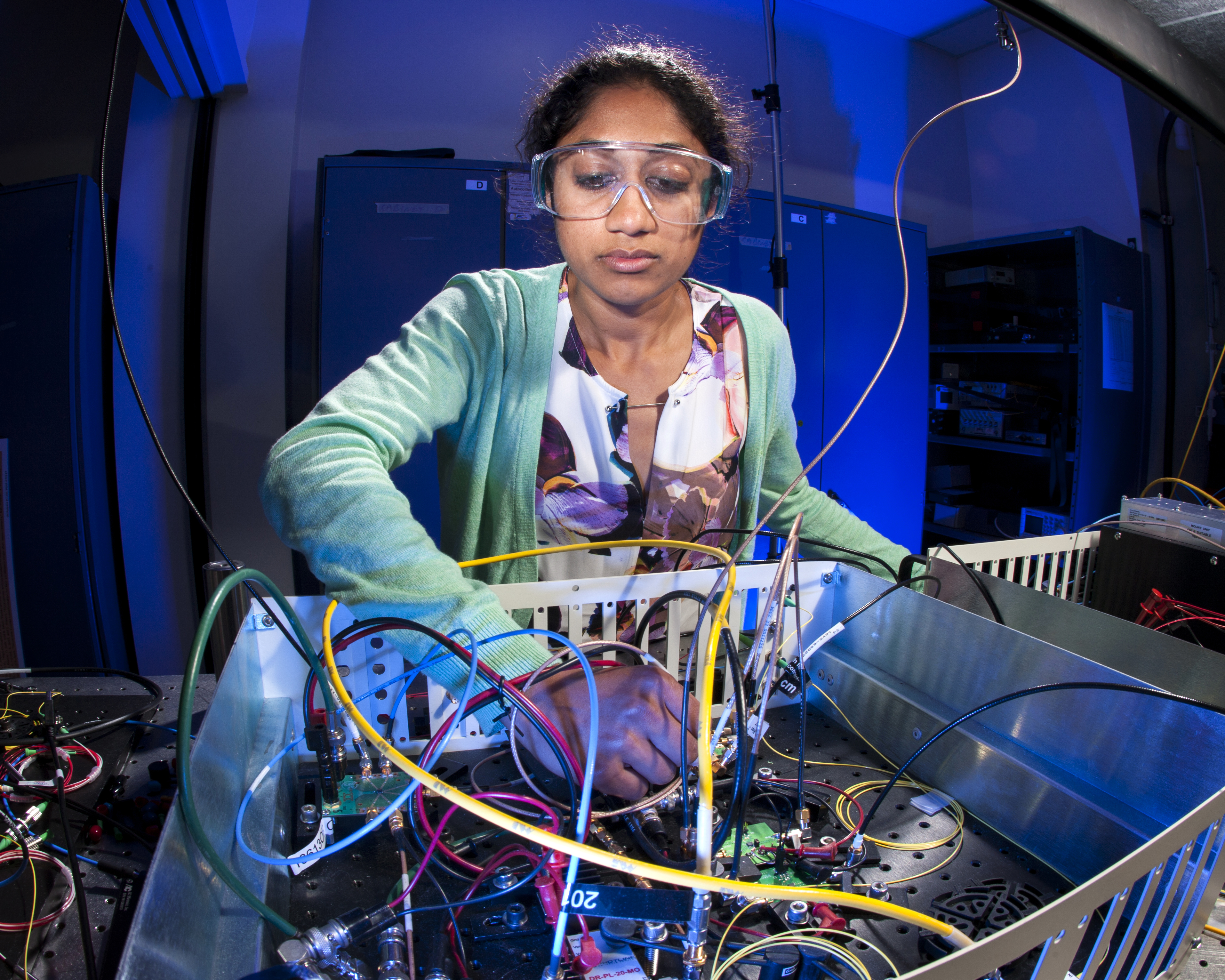Jason Chou (16-ERD-045)
Executive Summary
We are exploring a photon-based oscilloscope that could potentially boost the dynamic range of any electronic oscilloscope by up to an order of magnitude and is not limited by the noise and distortion found in electronics. This technology will allow measurements that meet the high dynamic-range requirements for laser-fusion ignition measurements such as those needed at Livermore's National Ignition Facility.
Project Description
Waveforms found in nature are smooth and inherently analog, containing vast amounts of information across an immense range of intensities. Detectors that measure these natural events are also analog, and therefore can preserve the original waveform with exquisite detail. Oscilloscopes allow us to collect and process these detected signals, but they have limited dynamic range, which creates an information bottleneck. We are exploring a photonic oscilloscope that is not limited by the noise and distortion found in electronics, to accurately capture continuous signals with greater than 1-GHz bandwidth using more than 1,000 levels in a single shot. Electronic oscilloscopes have traditionally exhibited two fundamental limits: a ceiling on the maximum input voltage allowed, so as not to cause front-end component damage, and a floor on the minimum detectable voltage. The former limit is imposed by power dissipation thresholds in front-end circuits. The latter, known as jitter, is rooted in quantization noise caused by uncertainty in the digitizer. We intend to develop a photon-based oscilloscope that can avoid these limitations found in electronics. Our high dynamic-range oscilloscope (HDRscope) will be unique in its ability to remove the input voltage ceiling, as well as lower the detectable noise floor to increase the dynamic range for many measurement needs. It couples the strength of high-resolution sampling found in optics with that of high-speed quantization found in electronics. This combination boosts the dynamic range of any electronic oscilloscope by up to an order of magnitude. A unique advantage of HDRscope, not found in traditional oscilloscopes, is the ability to perform remote and multiplexing functions. For example, the linear time-varying filter for the device can be placed at any desired location and used to transmit signals over a fiber without attenuation or loss of bandwidth. This allows measurements to be taken at remote locations where use of microelectronics is difficult or prohibited.
We expect that a successful project will result in a measurement device that avoids limitations found in electronics for many diagnostic needs. For example, neutron time-of-flight is a primary physics diagnostic to determine experimental yield, ion temperature, and other significant parameters that are key measurements in high-energy-density experiments, including fusion ignition research. Current neutron time-of-flight detectors have excellent linearity in neutron yield over the required dynamic range, but the oscilloscopes used to record these signals have hindered measurement accuracy, motivating the search for detectors with more dynamic range. We expect to design, build, and test a laboratory prototype of the HDRscope, which will sample continuous-time signals at 4 giga-samples per second over an input range greater than 100 V and a resolution greater than 1,000 levels in a single shot. During the project's first year, we will build models and algorithms essential to implementing a functioning system. During the two following years of the project, we plan to first demonstrate a prototype capable of sampling a 100-V signal at 4 giga-samples per second, resolved at 500 levels limited by noise. Next, we will develop a prototype capable of sampling a 100-V signal at the same sample rate resolved at 1,000 levels limited by noise. Creating each of these prototypes will require assembling components such as filters, multiplexing hardware, receivers, and amplifiers. An ongoing modeling and data-processing effort will continue throughout the project. We have extensive experience in simulating ultrafast lasers, nonlinear fiber optics, and electro-optic devices used by the system. It is anticipated that the modeling effort will be continuous and iterative in nature to help optimize the system and improve agreement between simulations and experiments. The simulations will guide design choices and identify hardware requirements to meet the second- and third-year goals of building prototypes that integrate an off-the-shelf source laser with the hardware modules we have developed.
Mission Relevance
A novel photonic oscilloscope that is not limited by noise and distortion found in electronic oscilloscopes will meet the high dynamic-range requirements for ignition measurements such as those needed at Livermore's National Ignition Facility, as one example. If successful, the HDRscope will couple the strength of high-resolution sampling found in optics with the strength of high-speed quantization found in electronics. It therefore will improve Livermore's capability in the core competency of lasers and optical science and technology, while enhancing the Laboratory's ability to meet mission requirements in Inertial Confinement Fusion research and high-energy-density science through enhanced diagnostics capabilities. These mission areas support the DOE goal to strengthen key science, technology, and engineering capabilities and modernize the national security infrastructure.
FY17 Accomplishments and Results
During the fiscal year, we (1) developed an end-to-end model that simulates the system and helps predict maximum theoretical levels achievable; (2) procured a 4 giga-sample-per-second sampling rate, mode-locked laser, which allowed us to build the system to meet our FY17 goals of 500 levels at 4 giga-samples per second; (3) implemented a novel, low-cost demodulation scheme, called RFIQ (radio-frequency to in-phase quadrature), which eliminates the need for a high-bandwidth oscilloscope as the digitizing instrument; (4) developed the concept that analog signals can be recorded and translated into phase changes along an in-phase and quadrature plot; and (5) experimentally demonstrated the concept by obtaining a plot circle using a 20-V sine wave corresponding to 2.6 revolutions.
   






